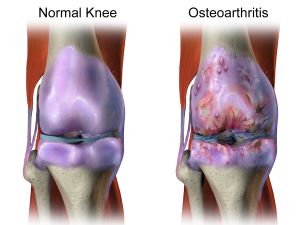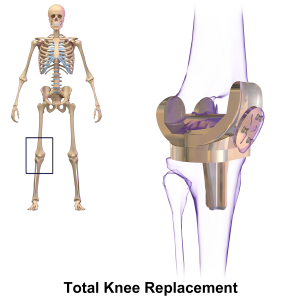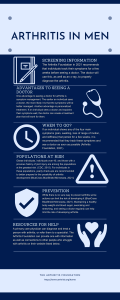Brandon Shealy
Introduction
Arthritis is a disease that involves painful swelling and stiffness in the joints of the body, most commonly in the knee and hip joints. According to the Centers for Disease Control and Prevention (2018), 19.1% of men from 2013-2015 were diagnosed with arthritis. There are several types of arthritis, but the two most common are osteoarthritis and rheumatoid arthritis. Osteoarthritis occurs when the cartilage in joints breaks away, causing bones to rub together. It is the most common form of arthritis and is more common in men than in women for people under the age of 45 (United States Department of Health and Human Services [USDHHS], 2017). Osteoarthritis is also the leading cause of disability among older adults, as the chance of developing arthritis increases with age (USDHHS, 2017). Rheumatoid arthritis is the second most common type of arthritis. Rheumatoid arthritis is an autoimmune disorder that causes loss of function due to long-lasting swelling in joints and break down of bone and cartilage (van Vollenhoven, 2009). Understanding the risk factors, symptoms, prevention, and treatment of arthritis can potentially increase the quality of life.

Risk Factors
The three main risk factors for arthritis are obesity, aging, and injuries to the joints. Obesity can lead to arthritis due to the extra bodyweight causing damage to the joints over time. Between 2013 and 2015, only 16% of underweight/normal weight adults were diagnosed with arthritis, but 23% of overweight and 31% of obese adults in the United States had arthritis (Centers for Disease Control and Prevention [CDC], 2018). It is recommended that obese or overweight individuals try to maintain a healthier weight to decrease their risk of arthritis. Aging is also a risk factor since bones become weaker and cartilage becomes more prone to damage. Yearly check-ups will allow for better preparation if one develops arthritis, leading to a better quality of life. Lastly, injuries to the joints, specifically knees and hips, increase the likelihood that arthritis will develop later in life (Blue Cross Blue Shield Minnesota, n.d.).
Symptoms of Arthritis
According to the Arthritis Foundation (2021), arthritis has four main symptoms: pain, swelling, a decrease in range of motion, and stiffness. Pain from arthritis could be a constant ache or occur in random flare-ups. The pain can happen when a person is resting or moving, and it may occur in the affected joint or across the body. The arthritic joint can also be red, swollen, and warm to the touch, which can cause pain and a decreased range of motion. Stiffness as a result of arthritis typically occurs in the morning or after sitting for long periods. Morning stiffness lasting longer than an hour is a sign of arthritis. All four of the main symptoms are typically more severe in women than in men, but arthritis is still one of the main contributors of disability in older men (van Vollenhoven, 2009). The Arthritis Foundation (2021) recommends tracking symptoms for a few weeks before seeing a doctor to help him/her diagnose the type and extent of arthritis.
Prevention
There is no real way to prevent arthritis, but there are actions a person can do to limit the risk of developing arthritis (BlueCross Blue Shield Minnesota, n.d.). Some common ways to lower the risk of arthritis include maintaining a healthy weight and controlling blood sugar to prevent type 2 diabetes. Both of these help decrease the wear and tear on the joints. Exercising and stretching also can help reduce the likelihood of arthritis by strengthening the muscles and tendons surrounding the joint. Exercises like riding a bike or swimming can reduce the risk of arthritis, as these are non-weight bearing exercises. Routine check-ups with a doctor may be able to catch arthritis at an early stage, therefore allowing for better management and an overall better quality of life.
Treatment
Research performed by the Mayo Foundation for Medical Education and Research (2019) suggests medication, physical therapy, or surgery as treatment options for arthritis. Arthritis medication can be painkillers like Tylenol or prescription drugs like oxycodone. Medicine could also be anti-inflammatory like ibuprofen or ointments that contain menthol. Medication is mainly used to manage the pain and symptoms of arthritis. Physical therapy for arthritis focuses on regaining function, range of motion, and strengthening the arthritic joints, which can also help reduce the pain and lead to a better quality of life.
The last treatment option, surgery, is the most extreme. The three main types of surgery associated with arthritis are joint repair, joint replacement, and joint fusion. During a joint repair, the surgeon simply removes the arthritic tissue from the joint (Mayo Foundation for Medical Education and Research, 2019). In a joint replacement surgery, the surgeon removes the arthritic tissue and replaces it with an artificial joint (Mayo Foundation for Medical Education and Research, 2019). A study on total knee replacements found that patients saw an 85% improvement in their symptoms after surgery (Weinstein et al., 2013). Lastly, joint fusion occurs mainly in smaller arthritic joints where the arthritis is removed, and two or three smaller bones are fused together (Mayo Foundation for Medical Education and Research, 2019). A doctor can help determine which treatment option can have the best outcomes to reduce symptoms.

If a man goes to the doctor when he first notices arthritis symptoms, he can select a treatment that can slow the progression of the disease. Typically, like most diseases, the earlier the arthritis is diagnosed, the better the treatment will help the symptoms. Yearly check-ups and keeping track of any arthritis symptoms can aid this process. Below is an infographic that discusses benefits of seeing a doctor and when to go to the doctor, as well as summarizes other points from the chapter.

Chapter Review Questions
1. What treatment style for arthritis focuses on the range of motion, strengthening joints, and regaining function?
A. Medication
B. Joint replacement
C. Physical therapy
D. Joint fusion
2. Which of the four main symptoms of arthritis typically occurs in the morning or after long periods of sitting?
A. Pain
B. Stiffness
C. Swelling
D. A decrease in range of motion
3. All of the following are risk factors for arthritis EXCEPT?
A. Being physically active
B. Obesity
C.Previous injury to joint
D. Aging
References
Arthritis Foundation. (n.d.). Do I have arthritis? https://www.arthritis.org/health-wellness/about-arthritis/understanding-arthritis/do-i-have-arthritis.
Blue Cross Blue Shield Minnesota. (n.d.). How to prevent arthritis pain. https://www.bluecrossmn.com/wellbeing/preventive-care/how-prevent-arthritis-pain.
Centers for Disease Control and Prevention. (2018, July 18). Arthritis-related statistics. https://www.cdc.gov/arthritis/data_statistics/arthritis-related-stats.htm.
Mayo Foundation for Medical Education and Research. (2019, July 19). Arthritis. Mayo Clinic. https://www.mayoclinic.org/diseases-conditions/arthritis/diagnosis-treatment/drc-20350777.
United States Department of Health and Human Services. (2017, May 01). Osteoarthritis. National institute on aging. https://www.nia.nih.gov/health/osteoarthritis#:~:text=Osteoarthritis%20is%20the%20most%20common,in%20men%20than%20in%20women.
van Vollenhoven, R. F. (2009). Sex differences in rheumatoid arthritis: more than meets the eye…BMC Medicine, 7, 12. 10.1186/1741-7015-7-12
Weinstein, A. M., Rome, B. N., Reichmann, W. M., Collins, J. E., Burbine, S. A., Thornhill, T. S., Wright, J., Katz, J. N., & Losina, E. (2013). Estimating the burden of total knee replacement in the United States. The Journal of Bone and Joint Surgery. American Volume, 95(5), 385–392. https://doi.org/10.2106/JBJS.L.00206
the point of contact between elements of an animal skeleton with the parts that surround and support it
translucent and somewhat elastic tissue found between joints
A disease in which the body's immune system attacks healthy cells
the full movement potential of a joint
counteracting swelling; used to prevent or reduce swelling
